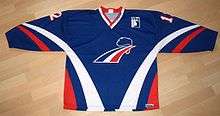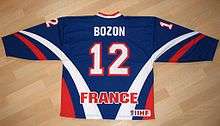Hockey jersey

A hockey jersey is a piece of clothing worn by ice hockey players to cover the upper part of their bodies.
Design

Hockey jerseys, sometimes referred to as sweaters, today are typically made of tough synthetic materials like polyester, to help take away moisture and keep the wearer dry. In accordance with the team's colors and matching the socks, they are usually emblazoned with the team's logo on the front, the player's last name on the upper back, and a designated number below, from 0 to 99. The design is often adapted for specific cases, such as Vancouver Canucks teammates Henrik and Daniel Sedin whose last names are accompanied by their first initials on the backs of their jerseys as they share the same last name on the same roster. The National Hockey League no longer permits 0 nor 00 for jersey numbers, as they cannot be entered into the NHL's database,[1] and the available numbers only go up to 98 since the League retired the number 99 in honor of Wayne Gretzky.[2]
A team captain wears an uppercase "C" above and to the right of the team logo on their sweaters (although a few NHL teams have the uppercase letter above and to the left of the team logo). Two other players, designated alternate captains, wear an uppercase "A" on theirs. Sweaters worn in European leagues and tournaments are adorned with ads, a concept borrowed from football jerseys. Most professional ice hockey teams sell replica sweaters of their famous players at their arena, as well as through sports memorabilia stores.
Fashion item
The cultural impact of the hockey sweater in Canada is encapsulated by the short story The Hockey Sweater by Roch Carrier. In it, a young hockey fan asks his mother to order a Montreal Canadiens sweater from an Eatons department store catalogue, but instead accidentally receives a sweater for the team's arch-rival, the Toronto Maple Leafs, much to his embarrassment and the derision from his friends. The story was later made into a short animated film of the same name, which was produced by the National Film Board of Canada; a quote from it appears on the Canadian five-dollar bill.
See also
References
- ↑ Pinchevsky, Tal (November 30, 2016). "Why goalies are increasingly ditching traditional No. 1". ESPN. Retrieved August 28, 2017.
- ↑ "Perfect setting: Gretzky's number retired before All-Star Game". CNN Sports Illustrated. Associated Press. February 6, 2000. Archived from the original on November 12, 2013. Retrieved June 9, 2014.
External links
| Wikimedia Commons has media related to Hockey jersey. |